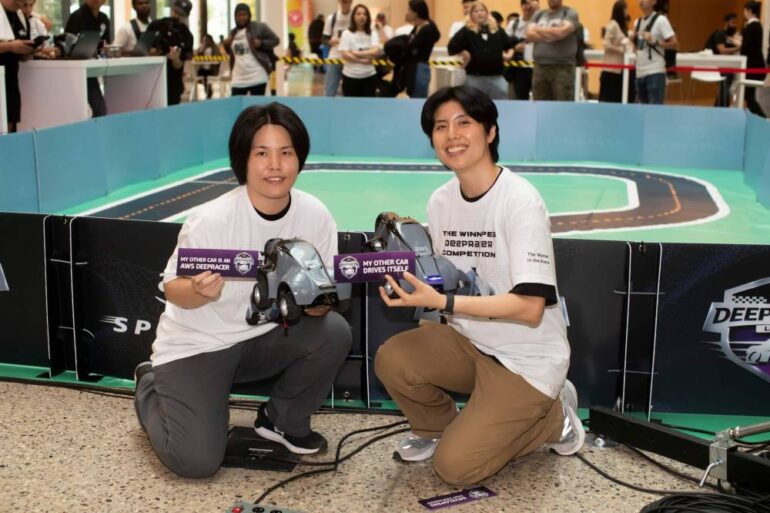TL;DR:
- Teams tested machine learning models on a miniature racetrack at Red River College Polytechnic’s campus.
- The event featured a partnership with Amazon Web Services, marking a significant collaboration.
- The post-secondary sector is exploring AI’s potential and its role in education.
- Demand for AI skills is on the rise across various industries.
- Amazon is investing in a $4.3 billion cloud computing hub in Canada.
- The event showcased the importance of embracing AI as a tool in education and industry collaboration.
Main AI News:
In the fast lane of technological innovation, teams put machine learning models to the test on a makeshift racetrack at Red River College Polytechnic’s Manitou a bi Bii daziigae campus. The miniature car darted left and right, narrowly avoiding careening off the course. Fortunately, no collision occurred, ensuring the safety of Sam Lee, the operator. This diminutive vehicle, a mere one-eighteenth the size of its real-life counterparts, navigated its way within knee-high barriers adorned with the emblem of Amazon Web Services, all without the presence of a human driver or passengers.
Sam Lee, eagerly awaiting her turn, was poised to program the small autonomous car with her artificial intelligence model. Her ambition? To develop a code that would keep the vehicle on the right track. “I’ve always been curious about machine learning, particularly in the context of self-driving cars,” she remarked.
Lee was part of a select group of 29 teams, comprising students and industry professionals, who converged at the college to test their machine learning models on this unique racetrack. What made this occasion particularly special was the college’s collaboration with Amazon Web Services, the cloud computing division of the tech giant Amazon. This partnership marked the first of its kind for the college, ushering in a new era of exploration into the realm of artificial intelligence.
As the post-secondary sector grapples with the boundless possibilities of artificial intelligence and its rapidly expanding influence, questions arise. How can institutions stay ahead of the curve and harness AI as a valuable tool rather than fearing its potential ramifications? Kirk Johnson, the college’s dean of business, information technology, and creative arts, posed this pivotal question. It was a question that would be explored that evening as academia and industry luminaries convened to deliberate on the future of artificial intelligence.
However, the day’s agenda primarily revolved around racing and leveraging Amazon’s cutting-edge programs. Sam Lee, though initially unfamiliar with machine learning, was determined to dive into the world of autonomous driving. She and her spouse turned to Amazon Web Services’ DeepRacer program, which served as their guide in creating a machine learning model capable of steering an autonomous car. Lee dedicated countless evenings to fine-tuning her virtual car’s performance on a digital racetrack, and the culmination of her efforts materialized on a sunny Thursday when she tested her model on an actual vehicle provided by Amazon.
Coral Kennett, Amazon Web Services’ Head of Education in Canada, emphasized the company’s commitment to investing in Winnipeg and Western Canada. This dedication coincided with Amazon’s construction of a $4.3 billion cloud computing hub in Calgary, set to open later in the year or early 2024. The hub is poised to create 950 full-time jobs across Canada, cementing Amazon’s substantial presence in the region.
As the day unfolded, the racetrack witnessed the participation of Juan Flores and Ruben Barrios, a current student and a recent graduate of Red River College Polytechnic. Their aspirations extended to securing positions at Amazon, underscoring the allure of machine learning skills. Whether it’s landing a role with Amazon or unlocking future career opportunities, knowledge of machine learning is indeed invaluable.
The demand for courses like DeepRacer continues to surge, with applications spanning various industries, including healthcare, education, banking, and manufacturing. A recent survey by Gallup and Amazon Web Services revealed that 67% of Canadian businesses faced challenges in finding digital talent. To bridge this gap, Amazon Web Services offers over 500 free online courses covering cloud technology, generative artificial intelligence, and other technological facets. Their ambitious goal is to train 29 million individuals by 2025.
The realm of technology can be overwhelming, necessitating hands-on activities like DeepRacer. Jordon Proctor, dipping his toes into artificial intelligence, expressed enthusiasm for his impending journey. Although not with DeepRacer, Proctor’s path was aligned with machine learning. As the Canadian Pork Council’s data and development manager, he envisioned the application of machine learning in disease modeling and other critical areas. “You can’t stop the march of artificial intelligence,” emphasized Kirk Johnson, acknowledging its ubiquity and inevitable proliferation. Therefore, post-secondary institutions must embrace AI, ensuring that students wield it as a tool to enhance their skill sets.
After all, companies like Amazon actively seek employees equipped with AI proficiency. Around 100 organizations were part of Thursday’s events, with some generous sponsors covering the day’s $50,000 cost. As the day concluded, participants gathered for an evening discussion on the future of AI. In this ever-evolving landscape, the trajectory of artificial intelligence remains uncertain. Nevertheless, this fusion of industry and academia, exemplified by the racing event, embodies the vision upon which the new campus was built—a harmonious collaboration between education and innovation, setting the course for a promising future.
Conclusion:
The partnership between Red River College Polytechnic and Amazon Web Services reflects a dynamic shift in the application of AI and machine learning. As these technologies continue to gain prominence across industries, companies like Amazon are poised to shape the future job market. To remain competitive, organizations should invest in AI education and development, preparing the workforce for a digital landscape that shows no signs of slowing down.

